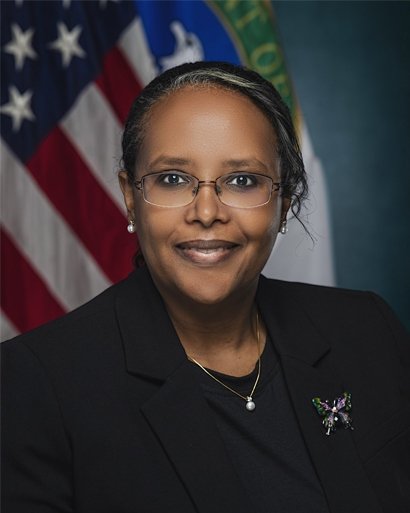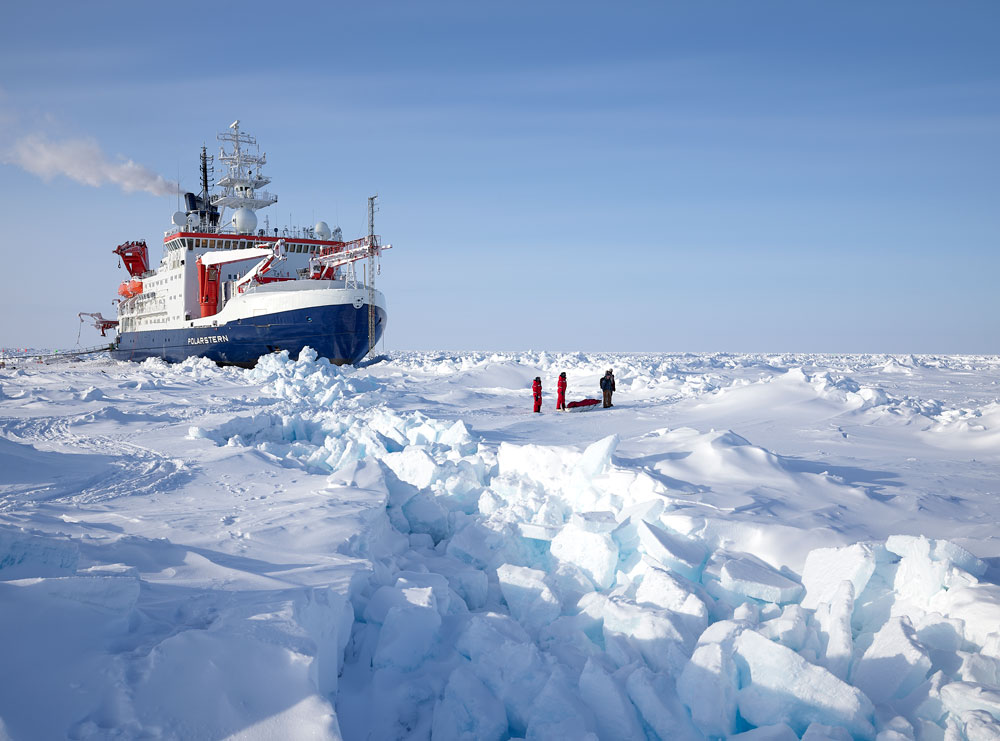Delving Into Earth’s Systems Today to Support the Solutions of Tomorrow
Published: 28 April 2023
Editor’s note: The original version of this column by Asmeret Asefaw Berhe, Director of the U.S. Department of Energy Office of Science, was published on the Office of Science website on April 21, 2023.

Droughts, thunderstorms, heat waves, and warming oceans. Climate change is harming people, communities, and ecosystems right now. During 2022 alone, there were 18 different weather and climate disaster events that caused more than a billion dollars in damage each. Climate change isn’t a future problem. It is a today problem that will only get worse as long as we continue to produce large amounts of greenhouse gases.
But we can solve this crisis. An alternative future is possible, but only if we take drastic action. The Biden Administration is supporting this action through our work to build a clean energy future and support for the Department of Energy’s (DOE) Office of Science.
Two years ago on Earth Day, I was nominated by President Biden to serve as the director of the DOE’s Office of Science. I’m now the first Earth scientist to lead this office. I’m a soil biogeochemist. My research at the University of California, Merced, focuses on how the soil system regulates the Earth’s climate, how essential elements cycle in the Earth’s systems, and the dynamic two-way relationship of humans with the natural environment. As such, it’s a great privilege to now work at DOE, particularly the Office of Science, where so much of the nation’s efforts on climate and clean energy are being coordinated. On the 2023 Earth Day, I want to share with everyone how the Office of Science works to address key issues in Earth system science.
DOE’s Office of Science is the nation’s largest supporter of basic research in the physical sciences. This work includes everything from high-energy and nuclear physics to fusion energy science to fundamental atmospheric science to solutions for our current climate and clean energy challenges. As we conduct this research, we’re also finding ways to improve sustainability at our labs and facilities.
Our long-running research serves as the foundation for many of the clean energy and energy efficiency technologies today, including batteries and LED lights. We are continuing these efforts by supporting the crosscutting foundational science for DOE’s Energy Earthshots. The Energy Earthshots are accelerating breakthroughs of more abundant, affordable, and reliable clean energy solutions to the climate crisis. There are six Earthshots, each with a different goal:
- Hydrogen Shot™: reduce the cost of clean hydrogen by 80%
- Long Duration Storage Shot™: reduce the cost of grid-scale energy storage with more than 10 hours of duration by 90%
- Carbon Negative Shot™: develop technologies that remove and store carbon dioxide from the atmosphere for less than $100/net metric ton of CO2-equivalent (CO2e)
- Enhanced Geothermal Shot™: reduce the cost of enhanced geothermal systems by 90%
- Floating Offshore Wind Shot™: reach $45 per megawatt hour for floating offshore wind by 2035
- Industrial Heat Shot™: develop cost-competitive industrial heat decarbonization technologies with at least 85% lower greenhouse gas emissions by 2035
The technology needed to meet the Earthshots’ goals fundamentally rests on solving basic science challenges. We recently invested $150 million into accelerating these breakthroughs.
Office of Science’s leadership in Earth system science observations and modeling
An important part of dealing with the climate crisis is measuring and documenting the past and potential effects of climate change. The Office of Science has a long-standing role as a leader in atmospheric systems research and Earth systems modeling.

Our Biological and Environmental Research program manages the Atmospheric Radiation Measurement (ARM) user facility, which has been collecting long-term climate data for more than 30 years. Scientists using ARM instruments have helped fill in major gaps in our knowledge, from the Green Ocean Amazon (GoAmazon) experiment to the MOSAiC expedition in the Arctic. Our researchers have also played an essential role in examining how ecosystems will respond to climate change. In our SPRUCE experiment, researchers have been collecting data since 2015 on how heating and increases in carbon dioxide affect a northern Minnesota bog.
This data has led to huge improvements in climate models, including the development of the Energy Exascale Earth System Model (E3SM). This advanced simulation of the Earth can help us project how ecosystems will react to climate change and how that can affect energy production and use. Last year, scientists launched a new global atmosphere model for E3SM that has a 30 times finer resolution than the previous one. It allows scientists to study the atmosphere with far more detail than before. Previous studies have shown that higher resolution allows researchers to better predict tropical cyclones.
Our computing facilities have also enabled these modeling capabilities. E3SM is designed to run on exascale computers, like Frontier at the Oak Ridge Leadership Computing Facility DOE Office of Science user facility. These supercomputers also make it possible to incorporate new types of data into Earth systems models.
Incorporating human systems into climate science
Western science has typically excluded humans from ecosystem studies. In particular, people from communities that are marginalized in society and minoritized in STEM, who bear the brunt of the climate crisis, have been excluded from both the process and benefits of research about the climate. However, we are increasingly realizing the importance of incorporating human communities into both our Earth systems modeling and field research. We are working to ensure representation of people from all walks of life in the scientific community that lead work on climate science, adaptation, and mitigation. We are also changing how the research we support considers people as part of the Earth system processes we study.
Our Earth systems models are increasingly including data on human activities. We’re expanding our ability to look at effects on a neighborhood-by-neighborhood basis, which is much more useful to communities than broad predictions. Recent research projects have examined the relationship between neighborhoods’ designs, heating and cooling patterns, and local weather, especially during heat waves.
In terms of field research, two of ARM’s recent projects are in urban areas.
Scientists participating in the TRacking Aerosol Convection interactions ExpeRiment (TRACER) took data and examined the relationships between clouds, pollution, and thunderstorms in the Houston, Texas, area. This region has a large number of industrial zones, including oil refineries and ports. The data will help scientists understand how human activities—including vehicle traffic and electricity production—affect the local weather and air quality. In the bigger picture, it should also help us better understand how hurricanes form and move. The data is freely available to anyone who wants to use it.

Similarly, the Eastern Pacific Cloud Aerosol Precipitation Experiment (EPCAPE) campaign is studying the atmosphere around San Diego, California. It will help us understand how gray marine clouds near cities on the coast form and the role of humanmade particles in their growth.
While these are both short-term campaigns, our urban integrated field laboratories are long-term collaborations to understand how urban areas interact with the climate. These labs bring science to the people rather than expecting them to come to us. Each laboratory is located in an urban area that deals with environmental injustices: Baltimore, Chicago, the Gulf Coast of Texas, and the southwest urban corridor (Tucson, Phoenix, and Flagstaff, Arizona).
The urban IFLs move beyond understanding the environment into informing solutions. They’re combining field observations, data analysis, and modeling to answer questions that are useful to marginalized communities. The urban IFLs engage a diverse workforce to include the many communities, identities, races, ethnicities, backgrounds, abilities, cultures, and beliefs of the American people. To ensure the solutions and research are equitable, local organizations and minority-serving institutions play significant roles. They provide input on both the highest priority research and how to use the results for the benefit of local communities.
Engaging communities in our research
“Expanding who participates and benefits from climate science is just a part of our efforts to make basic science more inclusive and accessible. By pursuing inclusive excellence, we are improving science and its place in society.”
Asmeret Asefaw Berhe, Director of the U.S. Department of Energy (DOE) Office of Science
Although the urban IFLs play a big role, they’re only part of our overall strategy to include communities in Earth systems science. Science is for everyone, so we must ensure it’s accessible to everyone.
One way we’re doing that is by expanding our citizen science opportunities. The Molecular Observation Network (MONET) takes the idea of doing science in your backyard literally. Hosted by our Environmental Molecular Sciences Laboratory Office of Science user facility, MONET is an open-science network that will allow people all over the country to contribute data. The project is inviting laboratory researchers, students, and citizen scientists to send in soil samples. Once scientists have analyzed them with the help of our Joint Genome Institute user facility, they will make this data available to everyone. MONET builds on the 1000 Soils project, which collaborated with Indigenous tribes and other communities to collect data from more than 1,000 soil cores across the U.S. These samples and data will help us better predict climate impacts on ecosystems. It will enable scientific discovery for everyone, to benefit everyone.
We’re also making information from climate and Earth systems science more useful to the people who need it. Through our HyperFACETs project, researchers are working with local decision-makers like water managers to make climate research more useful to them. The National Virtual Climate Laboratory will be a one-stop portal to climate science done at our national laboratories. It is focusing on connecting frontline communities that suffer the biggest impacts from climate change with the resources of our national laboratories, including workforce development.
In the future, we hope to expand these efforts into every part of our decision-making. Expanding who participates and benefits from climate science is just a part of our efforts to make basic science more inclusive and accessible. By pursuing inclusive excellence, we are improving science and its place in society. For example, our federal advisory committees—such as the Biological and Environmental Research Advisory Committee—make recommendations on the research to prioritize. We are taking steps to diversify these committees so that everyone is around the table when we make decisions.
The climate crisis presents us with both the challenge and the opportunity of a lifetime. Here at the DOE’s Office of Science, we’re building on our long history of Earth systems research to make sure that work includes and benefits everyone.
The Office of Science is the single largest supporter of basic research in the physical sciences in the United States and is working to address some of the most pressing challenges of our time. For more information, please visit the Office of Science website.
Keep up with the Atmospheric Observer
Updates on ARM news, events, and opportunities delivered to your inbox
ARM User Profile
ARM welcomes users from all institutions and nations. A free ARM user account is needed to access ARM data.


















